Just the Facts: A Social Studies Lesson
Teacher: All right girls and boys in our social studies we've been learning about American symbols.
Teacher 2: In today's integrated ELD lesson the children were working collaboratively together to create a poster filled with facts on one American symbol.
Teacher: On your posters, do I want to see any of these?
Students: No.
Teacher: I only want to see?
Students: Facts.
Teacher: I Only Want to See Facts.
Let's figure out what facts do we know?
Teacher 2: Today's lesson was really the culminating presentation lesson where they had to work together and create a poster and present it to the class and they were able to be the teachers today.
Joanna: The big eagle is on the one dollar quarter and it's on the one dollar.
Teacher: Nice. Good Joanna.
Teacher 2: San Francisco Unified encourages their teachers to utilize these five essential practices when planning their ELD instruction time for their students. For this class, this lesson I grouped my ELL's with my english speakers so that when they do work together they can help each other out. It's really building that collaborative model.
Teacher: What about our talking moves.
Students: Eyes and body show listening. Take turns.
Teacher 2: We started by reviewing our listening norms, our talking moves and I really had the rug partners just share facts about American symbols.
Teacher: Statue of Liberty. Lights. Camera. Action.
Teacher 2: I always use that practice to get my partners ready to learn.
Teacher: Start with the words 'The Statue of Liberty'
Students: The statue of liberty[crosstalk 00:01:58]
Teacher: Face your partner. That was his turn.
Female student: The statue of Liberty is called lady liberty. The statue of Liberty is holding something on a torch and it has something [crosstalk 00:02:13].
Teacher: Ba. Ba. Ba. Ba Ba.
Students: Ba. Ba.
Teacher: Okay. Are we taking turns?
Students: Yes.
Teacher: Thumbs up if you're using complete sentences.
Teacher 2: By doing that rug partner talk. It gets them into the game. They're ready to go.
Teacher: All right. Lets go over the ground rules of this game. You're gonna be the teacher. You're going to be writing only facts on your posters. How can we help our friends. What's one way we can help our friends. Aarf?
Aarf: You can help them read.
Teacher: You can help them read something that's on one of the booklets. What if they're not sure what fact to write? What can we do then? Evalina?
Evalina: You can help them write something that they think it's a good idea to write.
Teacher: Right. You can help them find a fact.
Do you guys feel ready?
Students: Yeah!
Teacher: Table monitors are gonna come up and pull a post-it that has a name on it and it's one of the symbols of our country.
male student: The white house.
Teacher: The white house there you go.
Teacher 2: When they got to their tables they had to work collaboratively and write down facts about their American symbol. They didn't know which symbol they would get which was great because they had to learn all five.
Teacher: When you write the facts. This is the way the poster is going to go so the words have to be this way. So, you should be standing over here on this side.
Teacher 2: Prior to this listen we reviewed the difference between a fact versus opinion, so that we got into our social studies lesson, they were able to create these posters with only facts.
Female student: Flag. Flag. We cannot touch the ground.
Teacher: Lets figure out which facts do we know. Fin, use the research you've got. We can put it here so everybody can see it.
Teacher 2: They had some resources at their tables. They had some books they could look into to refresh their memories. Pictures. But they used each other also.
Female student: The Liberty bell rang many times.
You're supposed to write like this way.
White House.
Teacher: Are we getting some good facts down?
Students: Yeah.
Teacher: So David get a marker. What do you know about the bald eagle, David?
Teacher 2: When I was walking around the tables, I did notice some students struggling.
Teacher: What are you writing about.
David: I don't know this. Some people did not want the bald eagle to be the national symbol.
Teacher: Well, is that the fact you want to write? Lets see. Lets keep looking. What facts do you remember about the bald eagle, David?
David: The bald eagle is..
Teacher: What do you remember.
David: I remember it comes back to the nest every year.
Teacher: What's that?
David: The bald eagle, it comes back to the nest every year.
Teacher: It comes to the nest every year. Returns to the nest every year. Returns. Re. Re. Returns.
Teacher 2: Referring them to resources was helpful and then reminding them to ask their friend at a table. It was good to see them use each other as a resource.
Students: Guiana. Guiana. Bald eagle here.[inaudible 00:05:47] No Guiana.
Teacher: Girls and boys you need to decide who's gonna read what fact off the paper. Amy, which fact are you gonna read? Amy, what are you going to read to the class?
Amy: I'm going to read.[inaudible 00:06:10]
Teacher: Can you read it to me?
Amy: The white house has a oval office.
Teacher 2: In order to promote the equity in my classroom, regardless of their language ability, I made sure that everyone had to as least present two facts during the lesson.
Teacher: Toby, what are your two facts that you're going to present off of this poster?
Toby: The bald eagle is not bald.
Teacher: Okay. One.
Toby: The bald eagle can live up to fifty years.
Teacher: Where is that in the book? Find that for me.
Toby: Oh, thirty-five.
Teacher: Thirty-five years.
Guiana, what are your two facts you're gonna tell the class now?
Guiana: The bald eagle [crosstalk 00:06:52] good eye sight.
Teacher: Eye sight or eyes.
Who's gonna be teacher first? Lets see.
Teacher 2: After the children were able to create the poster, they got to present the poster which was really exciting for kindergartners to be able to stand in front of the class and be the teacher.
Teacher: Remember what we're using? Complete sentences. You guys ready?
Students: Yeah.
male student: The statue of Liberty is made out of copper.
Teacher: Start with the American flag.
Camilla: The American flag has six white stripes.
male student 3: The American flag has six white stripes and seven white stripes.
Teacher: Can you give us another fact because that's what Camilla just said.
male student 3: The American flag has fifty stars.
Teacher: Nice.
Male student 4: The president lives in the white house. The white house was an American symbol for more than two hundred years.
Female student2: The white house has an oval office.
Teacher: Oval office. Nice.
Teacher 2: One thing that went really well today was the fact that my children were able to recall facts that we had gone over in social studies and were misconceptions for the students. I did a whole lesson one the facts that when Washington was our president there was no Washington D.C. There was no white house yet.
Teacher: What can we say about the white house?
FemaleStudent3: John Adams was the first president to live in the white house.
Teacher 2: I was really glad to see that one of my students was able to recall that fact. She wrote it down on the poster and then she was able to present that so that went well.
Teacher: Who are my next teachers?
Teacher 2: Reflecting on this lesson, I think that next time I'm going to have the students pick one color only and record their facts on that one color and then when their presenting they'll point to their color and read off their fact. That was there won't be any of that misconception of, wait a minute, you're reading off the fact that I wrote down.
Teacher: You can do it.
Guiana: The bald eagle is not really bald.
Toby: I was gonna say that.
Teacher: That's okay.
What's your second fact, Guiana. What's your second fact?
Guiana: The bald eagle eat fish.
Teacher: Nice. Lets move over to Toby.
Toby what are your two facts? Lets start with the bald eagle.
Toby: The bald eagle is not bald.
Teacher: Okay. It's not bald. What else can you teach us about the bald eagle?
Toby: The bald eagle lives up to thirty-five years.
Teacher: Good. I want you to think back. We did a lot of sharing before we did this lesson and your rug partner shared three facts. Were there any facts that you were able to use?
Oh Cynthia has some facts that she was able to use. Lewis and Gabriela used some facts from their partners. Look how much information's written on each poster. You guys are super stars today and you were the teachers. Girls and boys, I want you to thank your rug partner for the help.
Students: Thank you for help.
Teacher 2: In kindergarten, a lot of our students come in and the whole world is around them. My goal in kindergarten is to make sure that they start noticing people around them having that empathy and helping each other and working collaboratively.
Students: Can we do another one of these?
Teacher: You want to do another one of these afterwords.
Students: Yeah.


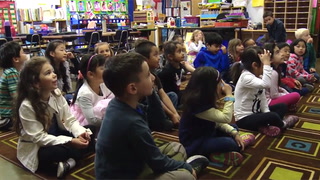
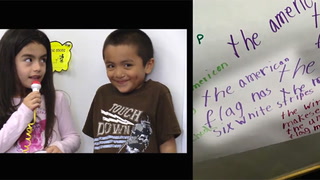

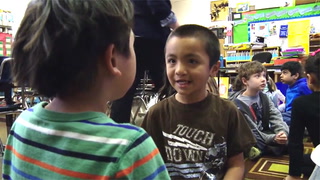


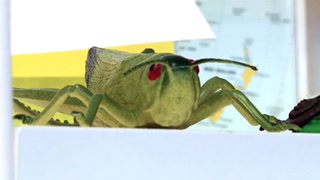
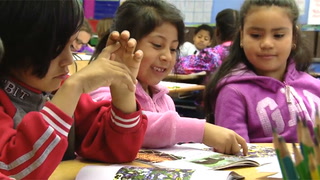
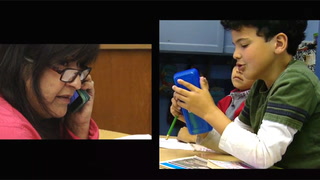










376 Comments
Paula Pleasant Dec 18, 2020 10:41am
This was great!! I will definately use this idea. The teacher previously taught the lesson about fact and opinions and the lesson about the American Symbols. This could be used as an asssessment for what was previously taught. The rug talk was a way to make sure that each student would feel comfortable and be successful in participating. It was great to see the students accessing prior knowledge, remembering what they learned. They had such fun being the teacher. It was a great idea to actually record them, they can hear it again later and the teacher can listen to determine what students were more comfortable with language, use of vocabulary, who is still a little shy, etc.... The teacher did say that next time to cut down on confusion about who wrote what fact she would assign each student their own color to write in. This was just great!!
McKenzie Steele Dec 14, 2019 2:34pm
I loved the idea of having the kids being the teachers by working together to create a poster to present to the class. I particularly liked how the teacher said she grouped her ELL students with her English speakers so they could help each other out when working together. She gave some great examples or different learning tools such as partner shares during their rug time, thumbs up to identify if students were following along, and encouraging students to help one another through group thinking and think-alouds.
Ms. Lwaszewicz did a great job incorporating the five essential practices during the lesson, but it was also encouraging to see that she still found things that she would change if she were to do this lesson again in the future. I have had that feeling every time I have given a lesson so far, so it is encouraging to know even those we, in my opinion, seem to have teaching mastered, still have those feelings. I enjoyed seeing the class work together so well, which is exactly the idea of the assignment was for.
Brianna Anglin Dec 11, 2019 12:52am
Ms. Iwaszewicz’s lesson and execution was spot on. Although this video is a culmination built on previous lessons, it was nice to see how this final project tied everything together. It was clear to me that Ms. Iwaszewicz has high expectations for her students. My practicum is in a kindergarten room and I often forget what 5 and 6 year olds are capable of; so it was a nice reminder that my students can accomplish so much more than I realize.
Ms. Iwaszewicz let the students become the teacher’s, which essentially made it easier for the students to become engaged and interested in the project. They were in control, within reason, of what was being taught during the lesson. The students were split into groups and had to create a poster filled with facts on an American symbol, and then present it to the class. During the presentation each student had to present two facts of their own to the class.
While the students were working Ms. Iwaszewicz circulated the room and interacted with the groups. She was able to see which students were thriving and which students needed more direction to complete the project. Some of the students had questions or were stuck on a particular part of the assignment, and instead of answering their questions Ms. Iwaszewicz challenged them to use problem solving. The students were able to find their answers by using their resources, such as their peers, books, and pictures.
Watching this short video helped remind me that there is always room for improvement. It was nice to see that although Ms. Iwaszewicz’s lesson was successful, she still found little things she would adjust for future lessons or projects, like assigning each student a specific color to write with so that they could identify their facts to present. By doing that she will give the students a sense of accountability for their work. She was successful in incorporating the Five Essential Practices during the lesson, as they were highlighted throughout the video. In conclusion, Ms. Iwaszewicz’s students met the goal she set for them, which was to work together with one another.
Byron Clark Nov 6, 2019 12:12am
I think this video, it’s points, and the presentation of it all was done very well. Seeing how Ms. Iwaszewicz practices her classroom management style, along with incorporating whole class and whole-body active involvement was insightful and beneficial to see as a teacher-in-training. I particularly appreciated the emphasis of her lesson being focused on teaching students at such a young age the difference between ‘fact’ and ‘opinion’.
More and more I feel and experience a seemingly disappearance of accepting the reality that ‘fact’ and ‘opinion’ are truly different. I currently teach in a 6th Grade ELA class, and our curriculum is highlighting the importance and the ability to use text-only facts and information that is collected from data, research, studies, and the text itself. For my 70-plus sixth graders, this is quite difficult for them. As I watched this classroom and these student in the video, I was impressed and encouraged to know that the challenges and triumphs experienced in the classroom are not always the same, nor always different, across the country.
Our district, and building in particular, has a large number of students who are ELL, new to country, migrant, or recent refugee to the States. I am encouraged to see how using appropriate strategies and techniques can help students of all ages integrate, enjoy, participate, and learn in a non-native language classroom environment.
I enjoyed the opportunity to listen to Ms. Iwaszewicz reflect on herself and her lesson. Listening to the changes she said she would make brought an encouraging perspective, as well as appreciation and acknowledgement that she is truly a dedicated and passionate pro-student learning teacher. I am thankful for her, and educators like her who set superb examples of what being a committed and successful teacher is all about. I look forward to incorporating some of her ideas and concepts into my own classroom.
Chad Armstrong Nov 3, 2019 9:48pm
I really enjoyed Ms. Iwaszewic's lesson in "Just the Facts: A Social Studies Lesson." I like how she uses group learning during the lesson, and allowing her students to work as teams to accomplish their presentation. Reminding students to ask other students if they have questions along with letting the students be the teacher in their presentation encourages the students to express their knowledge of the subject. This also holds students to a high standard during the presentation. The expectations are equal for all the students.
In my classroom, I combine a lot of lessons. In the first chapter of the curriculum, we went over government in ELA. In chapter three, we covered nature and animals in our readings and writings combining science and ELA. Ms. Iwaszewic way of combining subjects and holding students to high standards is very similar to what I have been doing in my classroom. By having the students give presentations, this allows for the teacher to informally assess the students at the end of the lesson. The one thing that I really thought was a great idea was telling the students that they are going to be the teachers today. I am going to incorporate this in my classroom when having the students present projects.